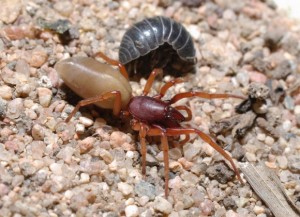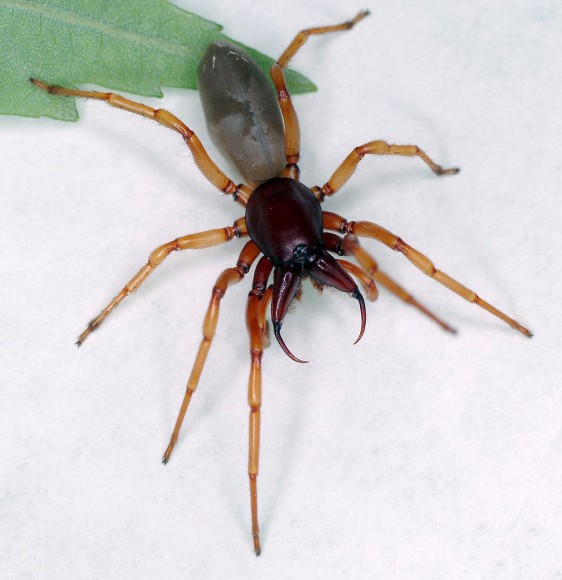Meet me in the garden . . . at night
The woodlouse spider (Dysdera crocata) is a lovely creature with a dashing personality and striking looks. My son and I were flashlight hunting the other night and found one beneath a bucket in the yard. They tend to alarm people.
You can see why. Amid the usual dark-colored scuttlers abroad at night, Dysdera might make you gasp (as it did my son) because of its coloration. The cephalothorax is a glossy red-amber that seems even bloodier by flashlight. The abdomen is a silky buff color, its texture such that it looks like a bobbin of silk thread. The legs are slender and pointed. There are six eyes—not the customary eight—in a horseshoe pattern, the curved part on top. It’s not a big spider, maybe the size of a quarter including legs, and you rarely see it in the open—and never dangling at nose level like those prankster orb weavers.
But those jaws! No magnifying glass is needed to see them. The woodlouse spider has long fangs folded into its chops like a pair of switchblades. It’s believed that the fangs are specially adapted for piercing sowbugs, which at the scale of Lilliput look like armored personnel carriers. A predator hoping to snack on a roly-poly needs armor-piercing weapons.
Another common name is “roly-poly killer.” I’m sorry, but that sounds a bit like “teddy bear assassin.” Or witty-bitty Jack the Wipper.

Then again … maybe I just want a salad. Like brussels sprouts, maybe pillbugs just aren’t to everybody’s taste. (Creative Commons / © Joseph Berger)
But there’s always something more to learn about spiders. It appears that Dysdera may attack the miniature crustaceans through their more vulnerable undersides, not through their dorsal armor, using just one fang to stab and the other to grip. That indicates a certain finesse, yes? Yet there have been several studies challenging the idea that Dysdera prefers pillbugs at all. What next—we learn the Goliath tarantula actually identifies with David? The mind reels.
Dysdera also sometimes bites people. It’s among the spider species that are ready to defend themselves—which means people malign them as “aggressive.” No, folks—defensive. Poke at Dysdera and she might poke you back. And since she’s the kind of garden spider you’re apt to encounter as you grub around among the kale without noticing where you set your hands, you might get a bite. (They’re also found in damp places like basements, where as a rule everything is scary.) But she will never chase you.
Bites by this spider are no big deal. Here’s a good article about them, using data from eight verified Dysdera bites (Actual data! Beautiful, beautiful data! No blame for the mysterious Invisible Spider this time). They’re like bee stings, or even less worrisome, since they don’t seem to provoke dangerous allergic reactions.
But: myths. Easy to see why this spider would make a good villain. It’s bright red on the front part, which sets off an instinctive danger signal in people. It has big fangs, the better to chomp you. Sometimes it really does bite. It stalks about at night, so you might never have seen one before. It loiters underneath things (as a hunting spider it doesn’t use capture webs). All it takes is a little misinformed push, and there will be online articles singling it out as a “dangerous spider” till the end of time. Here’s a posting from the Burke Museum’s FAQ on “myths about dangerous spiders”:
In 1993, a man with no medical or arachnological credentials somehow managed to get an article published in the respected New Scientist about a roommate who felt “a rapid series of jabs” while carrying furniture and later became seriously ill and noticed blistered skin around “puncture marks.” A spider found running across the floor hours after the supposed bite was Dysdera crocata, called the woodlouse spider because it preys on those land-dwelling crustaceans. Nobody should have taken seriously the conclusion that this spider was responsible for the man’s symptoms, but they did, and the “poisonous” nature of Dysdera entered folklore. According to one off-the-wall online comment, Dysdera venom “in very rare occurrences . . . can be fatal as a result of an allergic reaction” (that person must be psychic, since no such case has happened to date). This spider has very large and strong jaws, and can penetrate deeply when it bites humans, but a 2006 study of 16 verified bites showed that the main symptom was the pain of the puncture and that the venom had little effect. Unlike most spider bites, puncture marks from this spider’s impressive fangs can actually be seen about half the time.
I meant that to be comforting. Maybe it is? You can think of Dysdera the way you’d think of a bumblebee: a small animal that you shouldn’t hold, but that isn’t thinking about you and can’t do you much damage even if you’re careless.
We caught that night-roaming spider and kept her in a terrarium for a few days, even dropping in some lively pillbugs to see what she did. She did a lot of nothing, besides shrinking back from the roly-polys and trying to hide under the leaf litter. When she did move about, it was with a graceful stride, not that manic flailing a lot of captive bugs exhibit. Hmph. Some dangerous spider.
Soon enough, as usual, the minor guilt of taking an animal out of its home—the only home it will ever know for its short, short life before it has to DIE or be stepped on by the yard guy and re-enter the Circle of Life, blah blah—compelled us to set her free where we found her.
Remember, if you need a reason to let a spider live, Dysdera keeps the population of little gnawing garden pests under control. And provides a bit of wonder for children, both young and overgrown, who like to turn things over to see what lives underneath.
If Dysdera wants to move into those old gardening gloves I forgot to bring in out of the rain, go ahead. And we have roly-polys to spare.
BONUS: There’s a French band called The Woodlouses. They have a murky, angsty, indie tune called “Dysdera Crocata.” I didn’t hear the word “spider” among the lyrics, but maybe it was lurking under something else. Did I mention this spider is considered “cosmopolitan”?
